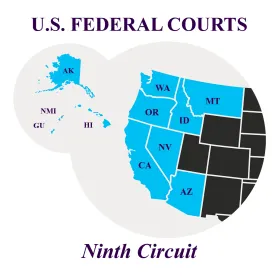The US Court of Appeals for the Ninth Circuit reversed a district court’s decision to dismiss a qui tam action brought under the False Claims Act (FCA) after analyzing the public disclosure bar channels. The case required the Ninth Circuit to examine Congress’s 2010 amendments to the FCA public disclosure bar to determine whether the claims were substantially the same as information publicly disclosed in any one of three enumerated channels. Silbersher v. Valeant Pharm. Int’l, Inc., No. 20-16176 (9th Cir. Aug. 3, 2023) (Schroeder, Sanchez, Antoon, JJ.)
The FCA imposes civil liability on anyone who knowingly presents a fraudulent claim for payment to the federal government. The FCA includes a qui tam provision that allows private citizens (or “relators”) to bring fraud claims on behalf of the government. In 2010, Congress’s public disclosure bar precluded qui tam actions if substantially the same allegations or transactions were publicly disclosed in one of three channels:
- In a federal criminal, civil or administrative hearing in which the government or its agent is a party
- In a congressional, Government Accountability Office (GAO) or other Federal Report hearing, audit or investigation
- From the news media, unless the action is brought by the Attorney General or the person bringing the action is an original source of the information.
Valeant owns the “Otterbeck patents” for its drug Apriso’s delayed-release formula. Valeant initiated an infringement action against Lupin, a generic drug manufacturer that attested in an abbreviated new drug application (ANDA) that the Otterbeck patents were invalid because of prior art that described a similar delayed-release formula. Thereafter, Valeant extended its monopoly by applying for and being granted a new patent that claimed a recent discovery that Apriso was effective when taken without food. GeneriCo then challenged the new patent in an inter partes review (IPR) proceeding, arguing that it was obvious that Apriso would be effective without food. GeneriCo presented two medical studies as support. The Patent Trial & Appeal Board agreed and invalidated the claims in the new patent.
Zachary Silbersher, GeneriCo’s IPR lawyer and a relator in another FCA suit in the same court, discovered that Valeant failed to disclose certain information to the US Patent &Trademark Office (PTO) during the IPR proceeding. Specifically, he discovered that three years before applying for the new patent, Valeant applied for another patent where it claimed it made an unexpected finding that taking Apriso’s active ingredient with food made the drug more effective. This claim was the opposite of the claim made in the new application that had been invalidated in the IPR proceeding.
Silbersher brought an FCA case seeking damages from Valeant, alleging that Valeant fraudulently obtained the Otterbeck and new patent to prolong its monopoly and charge an artificially high price for Apriso. The district court dismissed Silbersher’s qui tam action as precluded by the public disclosure bar because the IPR qualified as an “other Federal hearing” under channel two of the bar, as described above. Silbersher appealed.
The Ninth Circuit analyzed whether Valeant’s public disclosures occurred within one of the public disclosure bar channels and, if so, whether they disclosed substantially the same allegations or transactions as alleged in Silbersher’s qui tam action. Valeant used four sets of disclosures to argue that the bar applied:
- The patent prosecution histories of all of Valeant’s patents at issue
- The IPR proceeding in which the Board invalidated the new patent
- A Law360 article reporting on the Board’s decision
- The two medical studies.
The Ninth Circuit first found that the patent prosecutions of Valeant’s patents at issue were ex parte proceedings before a federal administration agency (in this case, the PTO) and qualified as “other Federal hearing[s]” under channel two.
Next, the Ninth Circuit addressed whether the IPR invalidating the new patent was a disclosure occurring within a bar channel. The Court found that an IPR does not qualify under channel two because it is not ex parte. An IPR is a trial-like, adversarial hearing conducted before the Board between patent owners and patent challengers at the discretion of the PTO. It has hallmarks of channel one as it is federal and the Board is an adjudicatory body of the PTO, an agency within the US Department of Commerce. However, the Court explained that the government does not participate as a litigant in an IPR and, as such, IPR proceedings do not constitute disclosure occurring within a bar channel.
Finally, the Ninth Circuit considered whether any qualifying disclosure revealed substantially the same allegations or transactions as Silbersher’s qui tam action. None of the public disclosures made a direct claim that Valeant committed fraud, so the Court analyzed whether they revealed facts from which fraud can be inferred. The Court had not yet interpreted the “substantially the same” prong of the public disclosure bar as revised in Congress’s 2010 FCA amendments. Citing its 2016 decision in Mateski vs. Raytheon, the Court concluded that the qualifying public disclosures did not disclose a combination of facts sufficient to permit a reasonable inference of fraud. Instead, these disclosures had one element or another but not both. Because the public disclosures did not reveal substantially the same allegations or transactions as described in the qui tam complaint, the Court concluded that the public disclosure bar was not triggered in this case.
The Ninth Circuit, therefore, reversed the district court’s dismissal and remanded the case for the district court to consider whether Silbersher’s qui tam action may proceed. In doing so, the Court indicated that it was not making any statement about the sufficiency of the pleadings but did note that the Federal Rules require fraud to be pleaded with particularity.




 />i
/>i
